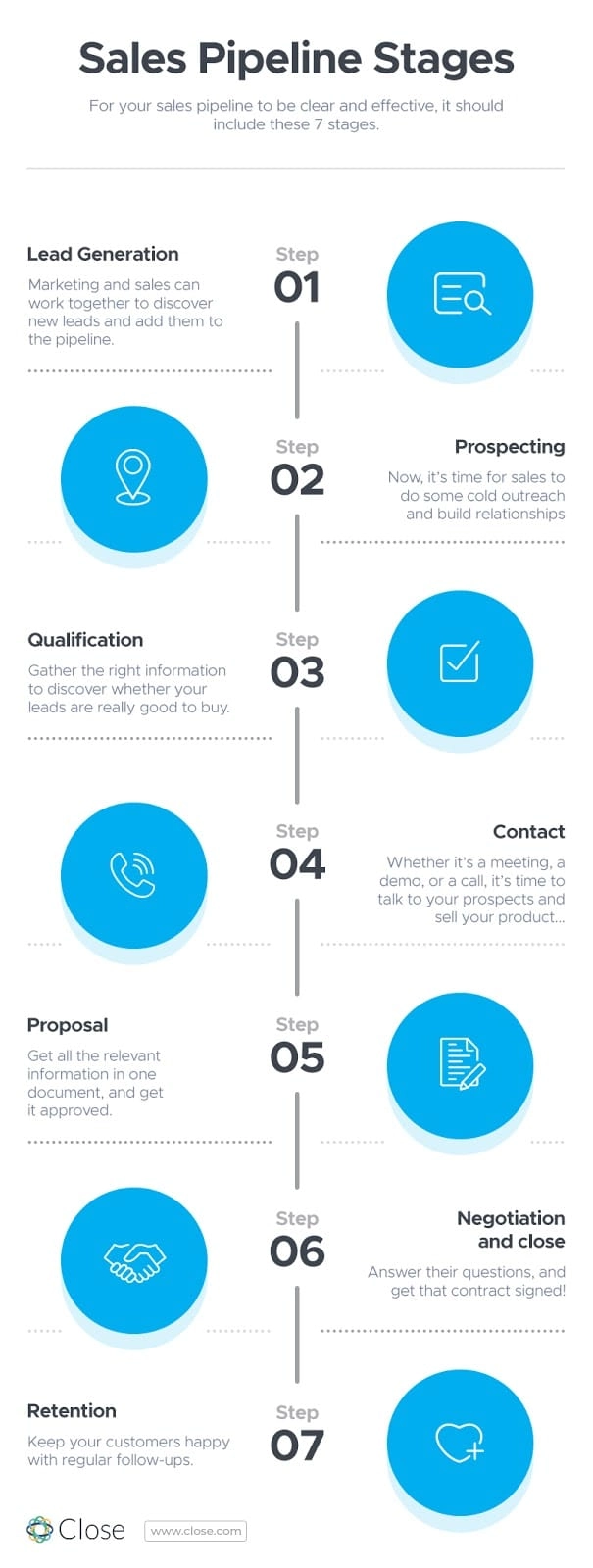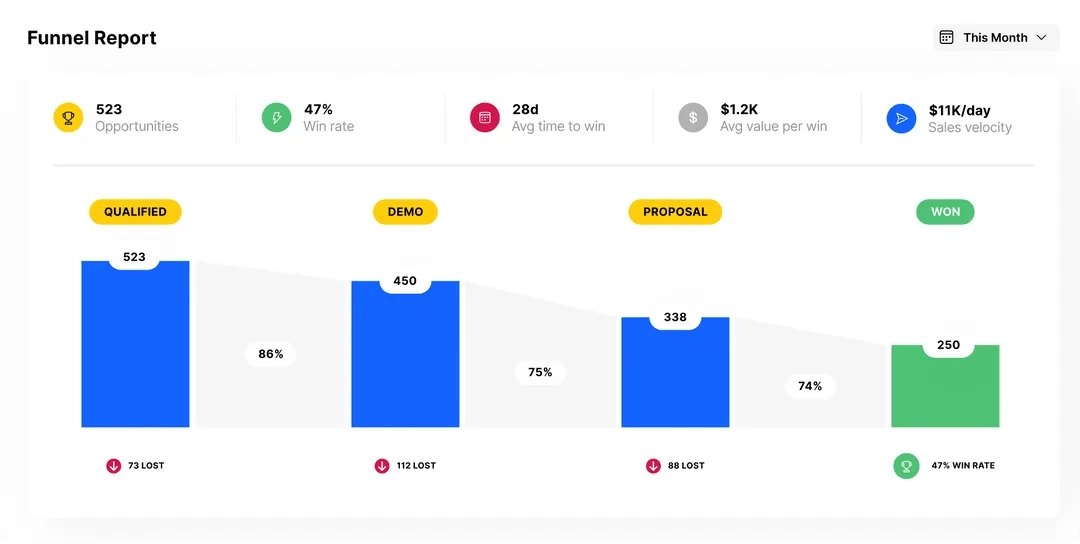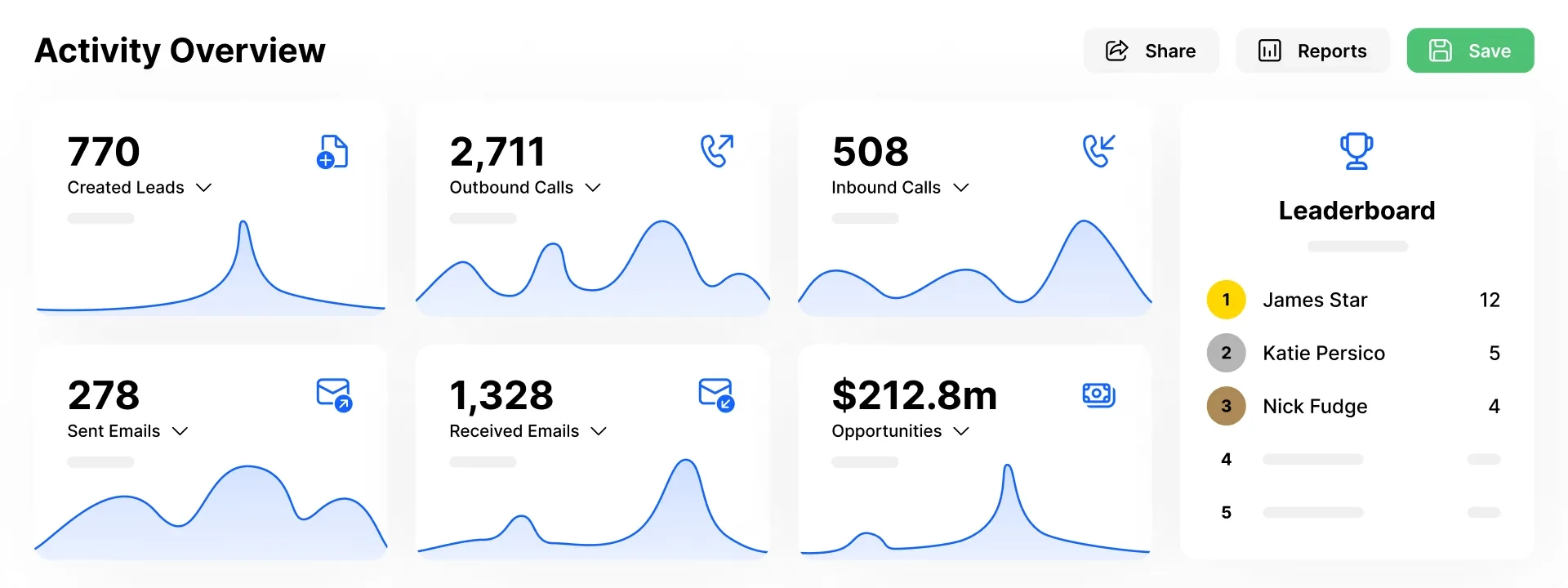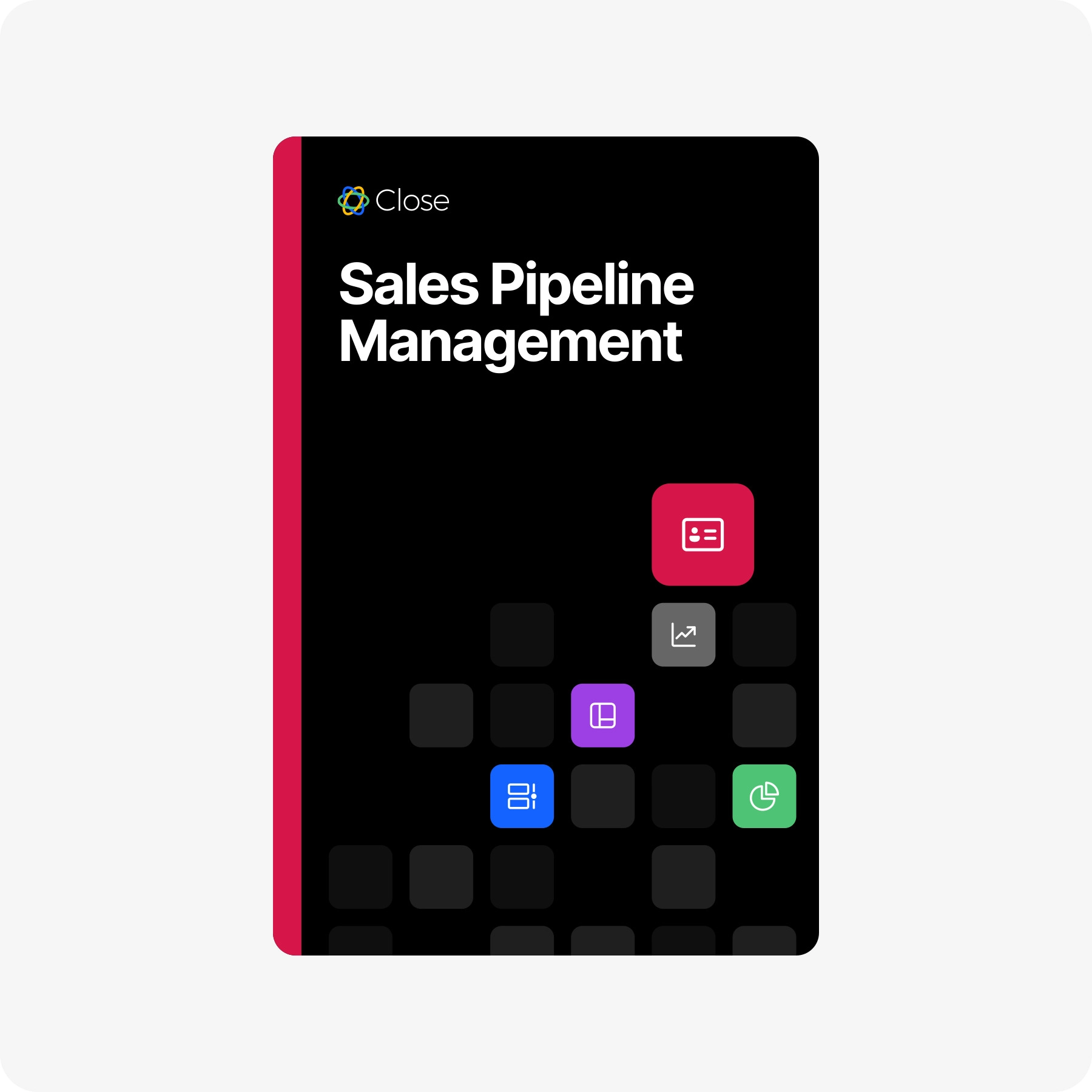Question for you: Are you taking full advantage of your sales pipeline?
A sales pipeline, or a visual representation of a company's sales process, is often divided into different sections, from lead generation to sale. Its purpose is to help sales reps streamline their workflows and successfully turn prospects into customers.
Here's the thing: Most sales teams have a sales pipeline, but few of them know how to manage it effectively. In fact, sales pipeline management is one of the toughest tasks in sales.
After learning the skills in this guide, you’ll be prepared to effectively manage your pipeline long-term, getting the most out of it now and in the future.
What is Sales Pipeline Management?
Sales pipeline management is the process of analyzing, tracking, and organizing your pipeline so that it runs smoothly and stays clean.
It’s the job of sales leaders and managers to take care of the pipeline, make sure it’s up-to-date, and improve it over time.
Why is this so important?
Because your current pipeline won't serve you well in a year or five years or ten years. The market is constantly changing, and your sales process needs to change with it. When that happens, your pipeline must adapt to fit current conditions.
When your pipeline is updated, improved, and cleaned over time, it allows reps to focus on selling and avoid getting lost in the noise of the pipeline. It also helps sales managers and leaders to see exactly what’s happening in the pipeline, where the most important deals are, and how their reps are performing at each stage.
Stages in the Sales Pipeline
People have been identifying sales pipeline stages since the late 1800s. I'm not joking. John H. Patterson did it to help close deals for his company, National Cash Register, in 1887.
These days, most sales teams divide their sales cycles into seven separate stages:
- Prospecting: This stage is all about lead generation. Your sales and marketing teams should attempt to engage inbound and outbound prospects via tactics like cold calling, email, and SEO (search engine optimization), and link building prospecting. This kind of prospecting specifically targets high quality backlinks that can boost your site's authority and search ranking.
- Qualification: The next stage is all about prospect evaluation. Not every person is a good fit for your company's products and services. You need to identify the bad-fits early in the sales process and remove them from your sales pipeline.
- Initial Contact: Once you've eliminated bad-fit prospects, you move on to stage three. In this stage, your reps reach out to potential customers and attempt to build relationships with them. The most used messaging channels are phone and email.
- Meeting/Demo: Some prospects will want to learn more about your products/services. This is the perfect time to schedule meetings and/or product demos. This gives reps the opportunity to guide prospects toward a sale.
- Needs Analysis: After meeting with prospects, your reps should have a good idea of what they need. Reps can then decide if your products/services will help prospects reach their desired goals. If they will, reps can move to the next stage.
- Close: At this part of the sales process, potential customers are ready to make a decision. Will they buy from you or will they walk away? If your reps have properly qualified their leads, given good demos, etc., they should close the deal.
- Follow-Up: The first sale is not the end! Successful sales reps always prioritize following up. This allows reps to stay top-of-mind with prospects, ensure a smooth onboarding, ask for referrals, and otherwise increase the likelihood of future sales.
Why is Sales Pipeline Management Important?
Proper sales pipeline management leads to bigger and more valuable deals, better forecasting, and higher sales velocity. Let's take a closer look at these three benefits.
More Valuable Deals
Proper sales pipeline management will help your team focus on quality leads that result in higher-value sales opportunities. Doing so will lead to greater company growth.
In fact, a recent Harvard Business Review study found that companies that prioritize pipeline management have an average growth rate of 5.3, a 15% increase.
Better Sales Forecasting
An effective pipeline management strategy will help your forecasting efforts, too.
How so? You'll be able to view each team member's activity metrics and the different stages their prospects are in. You can then combine these data points to determine how many sales your team will realistically make in the next 30, 60, or 90 days.
Knowing how much revenue your sales department will drive in the coming months is essential. Without this information, key decision makers in your company won't have the information they need to lead your company forward in an effective manner.
Higher Sales Velocity
Last, but certainly not least, proper sales pipeline management will increase your deal velocity.
By minimizing your sales cycle length, you'll close deals faster, which means your reps will have more time to engage and build relationships with other prospects. This is especially important in B2B sales, where sales cycles are generally longer than in B2C sales.
You have a need for speed—proper pipeline management will help you get there.
5 Aspects of Effective Sales Pipeline Management
Now that you know what sales pipeline management is and why it's important, let's talk about how you can streamline the process and improve your workflows.
This is probably a good point to pause and mention—managing and maintaining your pipeline is a lot easier with a robust, responsive CRM like Close. Check out our demo, and then carry on.
These five tips will help you manage your pipeline effectively.
1. Build and Maintain a Clearly Defined Sales Process
To build an effective sales process, you must develop a collection of repeatable steps that your team can use to push leads through the pipeline and convert them into happy customers.
When your sales process is clearly defined, your reps will understand what needs to happen in each stage of your sales pipeline to avoid bottlenecks.
For example, you may find that your process needs to be adjusted because of a change in the market or to your product. Maybe the customer journey has shifted, and the way people discover or interact with your business has changed. In these cases, you’ll need to adjust your sales pipeline stages to match current market conditions and ensure revenue growth.
Just make sure they always revolve around these seven main pipeline stages:

Give your reps a solid map—and then encourage them to follow it.
2. Forecast Like a Pro
Your sales pipeline shouldn’t involve guesswork. To effectively manage your team and the actions taking place inside your sales funnel, you need to generate data-backed forecasts.
Never just wonder what’s going to happen with your sales!
To forecast like a pro, track your entire sales process and the specific goals you've set for your team. Then, take certain information into account like how much your product costs, what you spend per lead, the potential market, and any upcoming fluctuations in price.
Finally, collect data on your pipeline and win rate. Are there leaks you need to plug? How often do new opportunities become paying customers?
With this information and an effective CRM like Close, you’ll be able to translate this data into accurate forecasts. (Note: Different sales forecasting strategies are valuable to different teams. You’ll need to decide what kind of forecasting you need to reach your goals.)
3. Eat Your Key Metrics for Breakfast
There are tons of important sales metrics that you need to be aware of.
But to manage your pipeline successfully, you should only focus on the metrics that really matter to your unique process. Avoid getting lost in a complex whirlwind of data.
Some of the key metrics you’ll need to keep an eye on, include:
- Pipeline value
- Average deal size
- Sales pipeline velocity
- Conversion rate per stage
- Sales rep pipeline performance

These and other essential metrics will help you keep an eye on the health of your pipeline. They'll also give you real-time insights about where to make adjustments.
4. Implement Effective Sales Rep Tracking
Monitoring your reps' sales activities inside the pipeline is essential to managing it efficiently.
It’s the job of the sales manager to make sure the right number of deals are assigned to each rep, prospects are contacted in a timely manner (by phone, email, social media, etc.), and opportunities are progressing through the pipeline consistently.
By monitoring your reps’ activities throughout the sales cycle, you’ll make sure everyone is playing an active part in building a sales process that wins.
5. Conduct Regular Sales Pipeline Reviews
The final aspect of sales pipeline management is the review process.
Schedule sales performance reviews every month or quarter, and use them to analyze and clean up your pipeline. How many deals did you lose last month? How many cold leads are cluttering up your pipeline? Which stage of the pipeline has the most leaks?
Analyze the data at your disposal to answer these questions. (Note: Pipeline management tools like Close make the sales process easier to evaluate.)
You can also use your sales pipeline review meetings to talk with your reps about current deals that are on the table, especially the big fish in the pipeline. Together, your team can discuss obstacles and brainstorm ideas to close faster.
Hack the Sales Process with Effective Pipeline Management Software
To manage your sales pipeline effectively (and not waste time!) you need to put specific processes and automations in place. This will get you the information you need without forcing you to sift through loads of data.
Let’s talk about five methods to hack the sales pipeline process and manage it more efficiently.
1. Use a Sales Pipeline CRM to 10x Automations
Building your sales pipeline in a spreadsheet (like SalesTable) can work for small teams. But you can boost your productivity by using a CRM to track and organize data automatically.
We may be a bit biased, but we think that Close is one of the best options to automate your entire sales pipeline process, from lead nurturing activities to closing the deal.
For example, Close’s reporting features include an Opportunity Funnel report, which gives you all of the key sales pipeline metrics at a glance, including:
- Conversion rates per stage
- Win rate
- Sales velocity
- Average time to close
Get the information you need to make effective decisions—without wasting a huge amount of time in the process. Close will help you get eyes on your data fast.
2. Use Forecast Templates That Integrate With Your Data
Choosing the right forecasting tools and templates will help you manage your pipeline better. It will also give you a more accurate view of where your sales team is headed.
For example, if you use a sales forecast template that can be converted to a Google Sheet, you can easily integrate this with other tools and data points using Zapier. Win!
3. Combine Rep Activity Data and Pipeline Conversion Rates to Plan More Effectively
Knowing exactly what your reps are doing at every stage of the sales process is only part of a high-level pipeline management strategy.
When you combine this information with other relevant data points, you’ll be able to see the future (without the help of Doc’s Delorean)!
Start by comparing rep activity data for a particular stage to their conversion rates.
For example, in the qualifying stage, which activities lead to conversions? Do reps who focus on calling close more deals than those who only send emails? Or is there a combination of phone and email touchpoints that lead to a greater number of conversions?
To answer questions like these, take time to analyze the data for each stage. Then, use said data to draw accurate conclusions and record them. For instance, you might find that:
- It takes at least 4 touches to get a meeting with a prospect
- Demos work better than sales presentations 74% of the time
Once you have these conclusions, you can coach your salespeople to perform the right actions at the right times. Using Close, for example, you can track rep activity and even set up a leaderboard. Reps who accomplish more of the target actions climb higher in the rankings.

These conclusions will also help you forecast more effectively. If you know that it takes an average of three follow-ups to finalize negotiations, for instance, you can more accurately predict the amount of time it will take to close new leads.
4. Integrate Different Tools to Automatically Track the Right KPIs
Your CRM is a great place to collect important data. But it’s not the only tool you’ll use to gather information and analyze metrics during the pipeline management process.
If you want to keep everything in order, you’ll need to set up a system to automate the collection of important data and bring it together into one central location. That way you won’t have to keep checking different tools and systems to find the data you need.
That’s why we love integrations at Close. By integrating your favorite data collection tools, you can gather relevant data based on the handful of essential metrics you picked for your team.
Once you know which metrics you need to track, make a list of the tools you need to use.
Start with your CRM. This is where you’ll collect data about your customers, open new opportunities, and view rep activity.
Then, add other tools. For example, do you use customer communication tools like Drift, MailChimp, or Zendesk? What about analytics tools like Gong or Google Analytics?
Once you have this list, find a way to integrate all of these apps.
Since Close CRM integrates natively with all of the tools mentioned above, you can collect and analyze in-depth data with no trouble at all.
If you want, you can feed your data into a Google Sheet, or you can display it visually using a tool like Geckoboard.

With this tool, you can create your own custom dashboard with information from various sources; then, display it for your reps to see. You can use Zapier to link Geckoboard to almost any tool you want, including Close.

By analyzing, organizing, and integrating your data across different tools, you’ll save time and have a better point of view to manage your sales pipeline effectively.
5. Use Sales Pipeline Templates for Reviews
Another way to level-up your pipeline management is to automate your review meetings.
While meetings are an essential part of managing a pipeline, preparing for and attending them takes time—time that decision makers like yourself could spend on other important tasks, such as analyzing rep performance and designing new sales strategies.
To reduce the time you spend on pipeline review meetings, use templates to automate your workflows.
For example, why not create an agenda template? This will ensure your meetings follow a similar pattern, which will help everyone stay on track. If you create your agenda template in Google Docs, your whole team can collaborate and add their talking points directly to it.
This agenda template could include items such as:
- Review action items from the last meeting
- Mention victories from the last week/month
- Have reps highlight one or two opportunities they’re excited about/facing challenges with and get feedback from the team
- Set clear action items for each rep over the next week/month
You can use custom metrics dashboards in these meetings as well. For example, you can use the Pipeline view in Close to ensure visual representation of your metrics, while you discuss current opportunities with your team. This will help make the numbers more relatable.
Use This Sales Pipeline Management Process to Level Up Your Pipeline
Let me ask you again: Are you taking full advantage of your sales pipeline?
By using the above steps to manage your pipeline efficiently, you’ll be able to track the right metrics, as well as your reps’ actions. Doing so will help you fully optimize your pipeline.
How so? Your reps will be better prepared to attend to the qualified leads in their pipelines, and you’ll have a clearer view of your current sales and future forecasts.
If you’re ready to fully optimize your pipeline for your business, you need the right tools to get started. See how Close can help you create a streamlined pipeline for your business.












